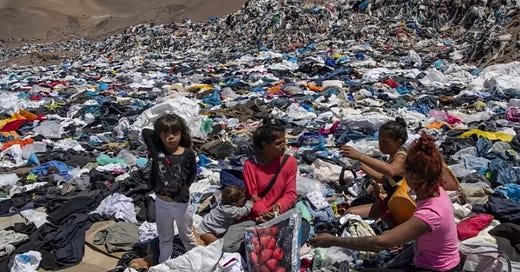Our Guilty Secret: When It Comes To Fashion, It Seems We Have No Sense
The state of our obsession with fast fashion has reached epidemic proportions, so what can be done to stem the tide?
Image: AFP
It’s an image we’re becoming sadly familiar with, perhaps not familiar enough, many would say because this is the Atacama desert in Chile, where, according to the UN, over 40,000 tonnes of clothes are dumped every year, many still with their labels on and in perfect condition.
According to one industry source who I spoke to, around 50% of all the clothes manufactured are never sold, instead lying in warehouses, only to then be sold on to third parties who in turn try to sell them on the grey market, resulting in the garments travelling around the world to find a buyer, to end up either being incinerated, dumped in landfill or discarded in places like the Atacama desert or Ghana.
The statistics are truly alarming; every year, across the world, we produce 92 million tonnes of textile waste. According to Business Waste, “unless big changes happen and improve how we make, use, and dispose of clothes, it’s estimated that by 2030 we’ll create 134 million tonnes of textile waste globally. And the global fashion industry is responsible for 10% of all greenhouse gas emissions”.
Back in September 2022, industry body the British Retail Consortium published guidelines to help keep clothing in circulation. Instead of throwing items away, the BRC advised that retailers can promote resale markets and platforms, use hire and rental subscription services, offer product swaps, upcycling, and repair schemes, and work with charity retailers.
The BRC said that its long-term goal is to limit and ultimately end items ending up in landfills unnecessarily and to keep them in circulation longer. This is on the back of data published by WRAP, which found that an estimated £140 million worth of clothing is sent to landfill every year.
Back in 2020, Greenpeace reported that, “we buy more clothes per person in the UK than any country in Europe. Around 300,000 tonnes of used clothes are burned or buried in landfill each year”.
Image: Waste Managed
And designer Stella McCartney was also quoted as saying, “Did you know that the equivalent of one garbage truck of textiles is burned or landfilled every second? And right now, less than 1% of material used to produce clothing is recycled into new clothing, meaning 99% of all textiles and fashion are waste… that’s about 100 billion dollars worth of materials wasted each year. It’s crazy!”
Whichever way one looks at it, our love of fast fashion shows no sign of abating. In a report by Waste Managed entitled “Fashion Waste - 2025 Facts and Statistics”, it revealed that the amount of textiles sent to landfill every year had increased to 350,000 tonnes; an increase of nearly 20% over 2020. The same report found that the average lifespan of a clothing item has decreased, with many items worn fewer than 10 times before being discarded.
Consumer education is clearly a huge issue, and whilst the lion’s share of the responsibility for this lies squarely with brands and retailers, it runs right through the supply chain.
Much of the reason for this wastage and the kind of statistics seen here are down to the way fashion brands, for decades, have merchandised. The simple truth being that fashion retailers' merchandising is flawed due to overproduction, fast-paced trends, and a focus on low-quality, disposable goods.
They would claim that they are supplying a consumer need, feeding our insatiable appetite for following trends, newness, and originality. Today’s next best thing, however, will be tomorrow’s landfill. Rinse and repeat.
And there’s one aspect of fashion waste which is probably the most shocking: returns.
According to a report from HSBC published in October 2023, some online platforms reported the rate of returns to be up to 50%. Reasons for this included bracketing, wardrobing (where items are intentionally worn once, typically for social media), and retailers offering free returns.
In a Just Style survey, it found that 62% of UK shoppers admitted to bracketing - the practice of purchasing multiple sizes and colours of the same garment with the intention of returning the unwanted items.
Separately, according to WSGN, in a report published in May 2024, it claimed that in 2023, only 13% of people admitted to buying clothes or accessories for an event, or social media (staging), before returning them. “Now, the combined rate of wardrobing and staging has risen from 13% to 30%. A huge jump”.
Back in November 2019, I wrote a piece for Forbes headlined, “Returns, an epidemic which the fashion industry chooses to ignore”, and it seems that, six years later, those were prophetic words.
For the piece, I logged onto a well-known fast fashion website and proceeded to order four different sizes of five different items, and at no point did I even get asked if I was sure that I wanted to do that. It would have let me check out with that basket, no questions asked.
So I decided to do the same exercise, six years later, to see if anything had changed. Back then, I didn’t name the retailer as I felt it would not have been fair, with pretty much every online fashion retailer allowing bracketing and staging.
This brand, however, has often been in the news, and for all the wrong reasons. Therefore, I decided to log on to boohooMan.com, and sure enough, it let me bracket away to my heart’s content.
I’m old enough (just) to remember when wearing a seatbelt in a car was made compulsory. Before then, there had been campaigns (clunk-click anyone?) to try to persuade us to wear seat belts, as it was felt to be a really good idea to wear one in the event of an accident.
It faced all sorts of objections, mainly on the grounds of infringing individual liberty; it was opposed by the Conservative Government and the Labour Official Opposition but, late in the evening of 28th July 1981, after 13 failed attempts by backbenchers in both Houses, a House of Lords amendment by Lord Nugent of Guildford, succeeded in the Commons. It was the result of years of campaigning by medical and safety organisations. The legislation was subsequently enacted into law on January 31st 1983.
That struggle sounds faintly ridiculous today, however, I would suggest that the same approach needs to be applied to fashion returns in order to reduce the amount of garments that end up in landfills, or the Atacama desert, with the resulting impact on the planet*.
Because it appears abundantly clear that, in the face of the fashion industry being reluctant or unable to self-regulate itself, the only way to alter consumer behaviour would be to introduce legislation. And returns would be the most straightforward and simplest way to do this, beginning with applying limits on bracketing.
It is high time that the industry took its responsibility seriously, because continuing on the current trajectory is not an option.
*The relationship between returns and discarded garments to incineration or landfill, known as reverse logistics) is well-established. The primary reason being that to return an unwanted garment to the rail for sale is often too costly or inefficient for the retailer.





